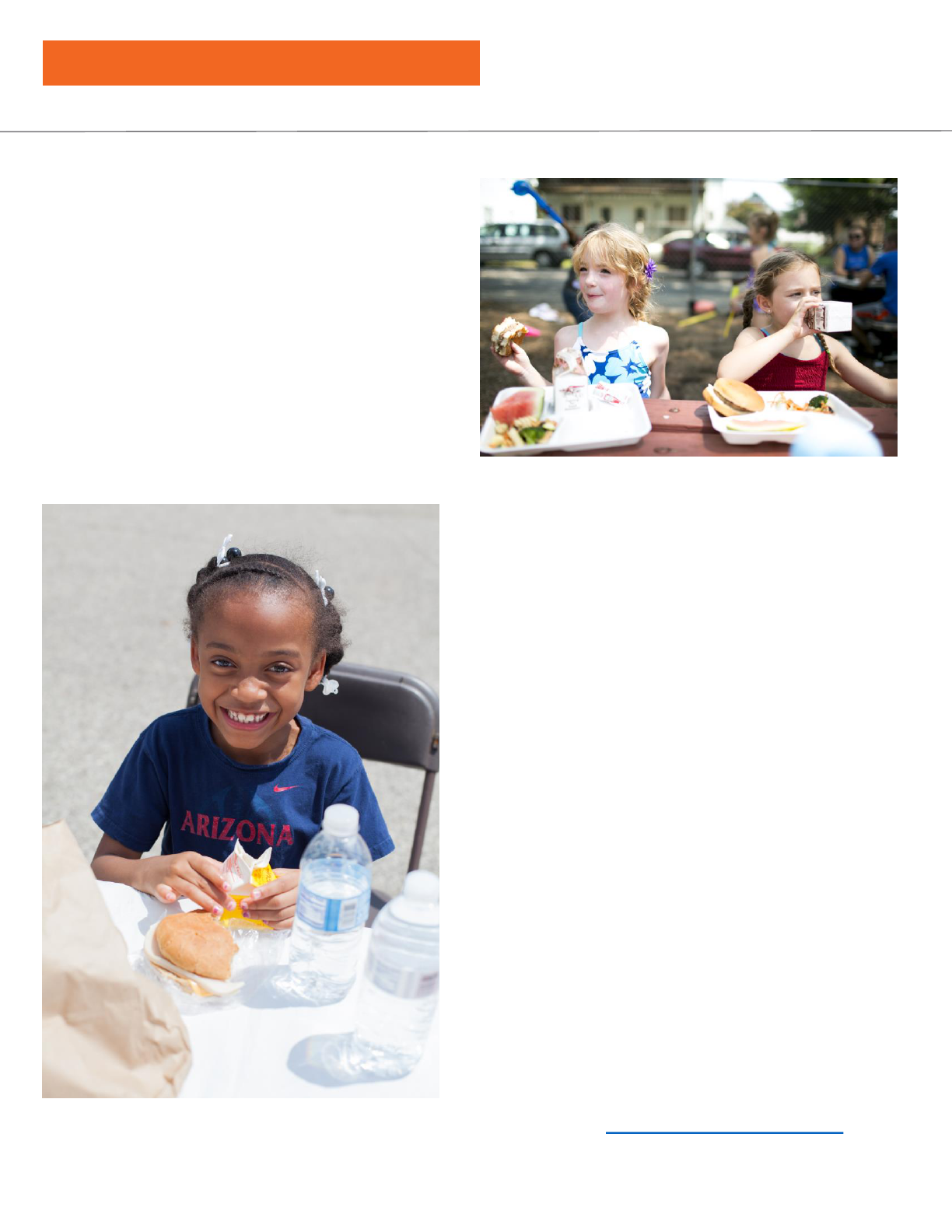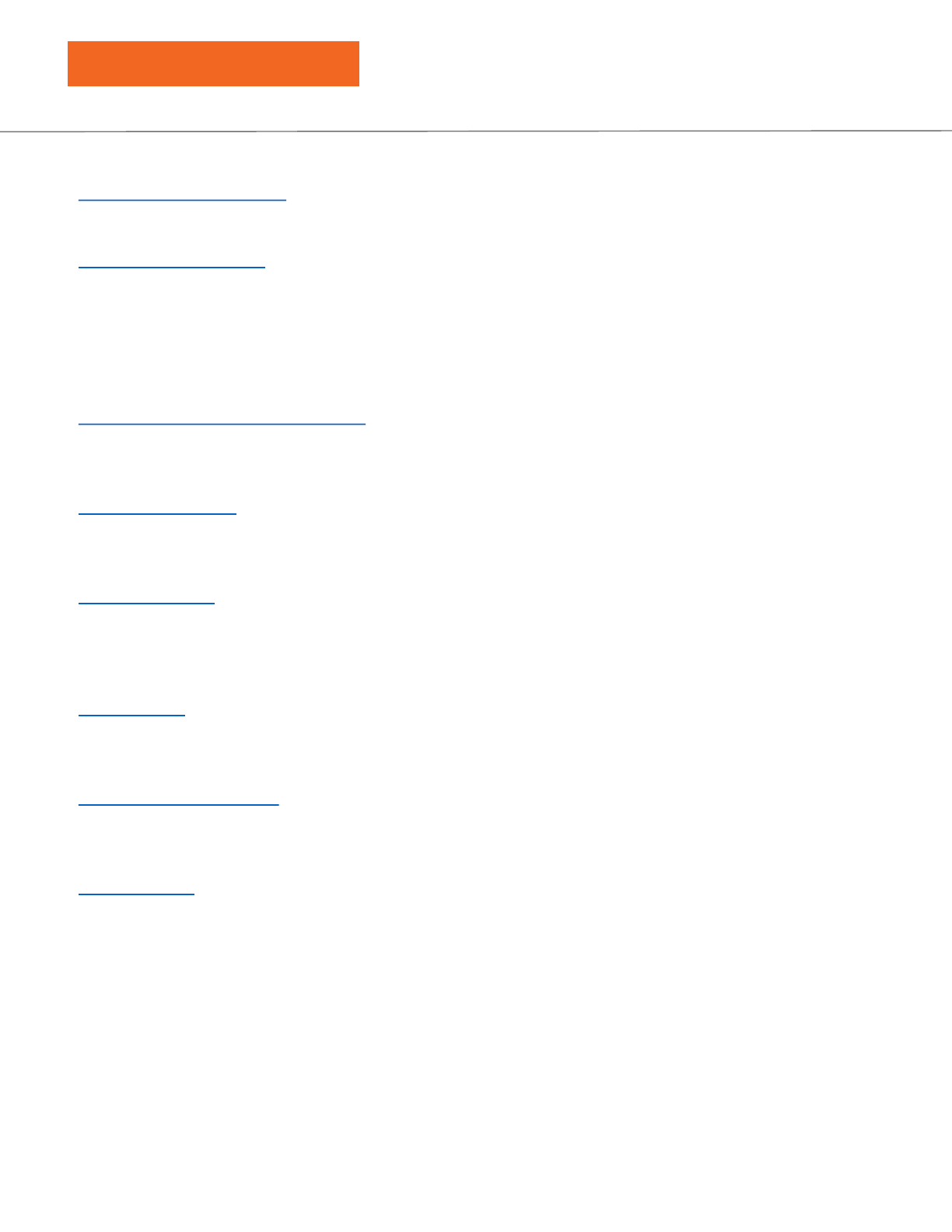
How To Build a Communications Strategy
A 2017 Summer Playbook

Welcome to Summer 2017!
Dear No Kid Hungry Partners,
Welcome to Summer 2017! We know you’ve
been hard at work pulling together a strategy to
make sure kids in your community are able to
get the nutrition they need while school is out of
session this year.
Thank you for your tremendous efforts; we know
your success is due to a lot of hard work.
Now that you have your strategy in place, it’s
time to get the word out. Whether you’re trying to
reach community leaders, opinion elites or
eligible families, we’ve created this Strategic
Communications Playbook so you don’t have to
start your efforts from scratch.
We’ve collected tips, best practices, and
customizable assets from experts and partners
around the country so you have the tools at your
fingertips to get the right people to take the right
actions at the right time.
Here’s how this document works: Each
section will have an introductory page, followed
by a concrete example. This is followed by a
page filled with customizable assets like images,
messaging, flyers and widgets that we think
could be helpful. Finally, at the end of this
document, you’ll find a blank plan to fill out as
your own communications strategies come
together.
We hope you find this useful. And we’d love to
hear about the great work you’re doing to use
communications and marketing to drive
participation in your communities, so please,
keep in touch. And good luck this summer!
Sincerely,
Christy Felling
Welcome
Summer Tactics Hotline
Have an idea, a question, or a best practice
to share? Stay in touch!
Communications: Christy Felling
Share Our Strength/No Kid Hungry
Director, Media & Public Affairs
202.320.4483
Best Practices: Derrick Lambert
Share Our Strength/No Kid Hungry
Program Manager, Summer Meals
dlambert@strength.org
202.478.6519
More Summer Tools
No Kid Hungry Center for Best Practices
https://bestpractices.nokidhungry.org/free-
summer-meals-kids
2

Part 1: The Three Phases Of A Plan
How to build a strategic plan based on goals,
audiences and message.

Overview
Three Phases of a Strategic Communications Plan
All successful strategic communications strategies have one thing in common: They begin
with a sharp focus on goals, audiences and objectives. This will lead to smarter decisions
around capacity, budget and ensure that strategy is driving tactics, not the other way
around. Before focusing on what we plan to do, take a moment to answer these questions.
Phase 1: Right Targets
Define GOAL
At the most basic level, what are we trying to accomplish this summer? Get as specific as
possible; what needs to happen for this summer to be a “win”?
Define PROBLEM
What is the problem we’re trying to solve? Is this a problem that is solved by
communications? Is additional outreach or media attention a solution? Or is this solved
through other means?
Define DECISION MAKERS
Who is the “right person” who can actually achieve our goal? Who has the power of “yes” or
“no” to achieve the goals we’ve defined?
Phase 2: Right Message
Define AUDIENCE
Sometimes our audience is our decision makers. Most of the time, our audience is made up
of the people who can reach our decision makers.
Define MESSAGE
What do we need this audience to hear? How does this audience usually get their news and
information? Finally, how can we make this message targeted and repeatable so it reaches
our decision makers?
Phase 3: Right Tactics
WHAT are we going to do? Build a tick-tock – a week-by-week tactical to-do list - making
sure they reach targeted audiences and help achieve our stated goals.
WHEN are you going to do it? Add a timeline to your tick-tock with budget, project leads,
assets attached.
HOW will you know it was successful? What do you plan to measure?
4

PHASE ONE: Right Targets
5
A successful strategic communications
campaign has one mission:
Getting the right people to take the right
action at the right time.
The most important first step is to clearly
define our focus. This will allow us to make
targeted decisions about tactics, capacity and
budget.
We need to:
Fight the urge to jump straight to tactics.
We need to take our time with this step to
clearly define what problem we are trying to
solve and who are the people who will
ultimately say “yes” or “no.”
Be as targeted as possible. “Increase
participation in summer meals” is an OK
goal, but “increase participation in summer
meals in these three specific counties which
have good transportation options” is even
better. Targeting “moms” as decision-
makers is OK, but “moms with school-age
children who are already seeking assistance
through WIC clinics” is even better.
As we develop message and tactics, let’s
constantly take a step back and make sure
everything we are doing has a direct
impact on our decision-makers and goals.
Remember: Sometimes the smartest
decisions are dropping tactics because they
aren’t on target.

PHASE ONE: Example
6
Example Targets: Summer 2017
What do we need to
achieve?
Problem to solve
Who makes this
decision?
Increase summer meal
participation, specifically
through building increased
awareness of the program in
high-need areas with
transportation.
Families are unaware that
meal programs exist, or are
unsure about how to
participate. How do we make
sure people know what meals
are and how to find
when/where they’re served?
Parents – the ultimate
decision makers to drive
participation rates.
State agency staffers – can
help with target data and in
scaling outreach.
Coordinate outreach efforts
among groups serving eligible
families for a streamlined,
smooth process.
Different organizations using
different messages and
outreach. How do we
coordinate messages with
faith-based, government,
advocacy, education and
parental groups? And how do
we identify and replicate things
that are working well with
specific partners?
Advocates – trusted voices in
the community (school,
church, sports) who can find
solutions for kids in need.
Set the groundwork to improve
program reach in areas facing
specific barriers, educating
influencers about potential
solutions, including the
effectiveness of summer EBT
pilots or mobile meals.
Summer hunger is still
“invisible” problem for officials
with power to collect data,
make policy changes. How do
we change conversation
around summer hunger to
make a priority?
Media elite – can elevate our
message so it reaches
lawmakers, influencers,
others.
Lawmakers –
can make policy
changes.

PHASE TWO: Right Message
7
Choose Our Audience
Sometimes our priority audience is made up
of our actual decision makers. Sometimes, it’s
made up of the people who can influence or
speak to our decision makers.
Each of our priority audiences will require
different messages and tactics, so we need
to be as specific as possible.
Choose Our Message
Once we’ve identified our priority audiences, it’s
time think through the best ways to connect
with our audience.
Questions to ask:
• How does this audience receive information?
(Radio ads? Twitter? Handouts from school?
Flyers?)
• Who are the most trusted messengers to
convey this information? (Teachers? Church
leaders? Articles in the news? Word of mouth
from friends?)
• What are the top worries, concerns or
passions of this audience?
• How much does this audience already know
about summer meals?
• What is the current environment? Are there
external factors who could affect our
message?
Click here for sample summer messages to
customize for specific audience needs.

PHASE TWO: Example
Example: Audiences and Messages
We find our summer audiences generally fall into three “buckets.” Here is an example chart:
8
Audience
Where Audience
Gets News
Action To Take Primary Message
POTENTIAL
PARTICIPANTS
• Parents
• Kids themselves
• Word of mouth from
friends
• Respected leaders –
school, health,
church
• Organizations
already offering
services
• Media – radio ads,
non-cable TV ads,
social media
Participate in the
summer meals program
• What are summer
meals?
• Texting number
• Impact
• Safety/trusted sites
• Free, supervised
meals
COMMUNITY
ADVOCATES
• Hunger/poverty
allies. Educators
• Service offices –
WIC, lawmaker,
other
• Health –
Pediatrician
• Site operators –
faith, library,
community orgs
• Peer-to-peer –
newsletters, blogs,
social media
• Direct outreach from
community leaders,
NKH partners
• State agencies
Share information about
how to participate in the
summer meals program
• How to find summer
meals
• Sharing outreach
materials
• Barriers kids face
• Impact of program
on health, education,
well-being
THOUGHT LEADERS
• Lawmakers
• Op-ed writers
• Business leaders
• Education leaders
• Op-Eds/ Social
media
• Hands-on
experiences
• Peer-to-peer –
legislative,
education, business
journals
• Create the policies
that end childhood
hunger
• Make ending
childhood hunger a
top priority in the
community
• Set the stage to
attract new sponsors
next year
• Urgency of summer
hunger
• Impact of summer
hunger (health,
education)
• Barriers to summer
meals

PHASE THREE: Tactics
9
Create Our Tick-Tock
Putting our tactics and activities into a living,
organized chart - a tick-tock – keeps our
campaign strategic. A great tick-tock has five
key parts:
• Tactic – what is the most direct, specific
thing we can do to reach your audience? And
does it help to reach our stated goal?
• Timeline – Put specific dates to tactics. Find
ways to bundle tactics so they create a burst
of activity.
• Assignments – Designate who is taking
lead, who needs to sign off, and who is
needed to execute
• Budget – Take time to budget both money
and capacity. Be realistic!
• Measurement – What does success look
like? How will we measure both outputs and
outcomes?
List Our Tactics
Once we have our goals, audience, message
and calls to action, it’s finally time to think
about tactics and activities.
Some examples of tactics include kick-off
events, backpack flyers, radio PSAs, social
media, meetings, phone calls, paid ads,
newsletters, site visits, and op-eds.
For each tactic, ask ourselves, will this directly
reach my priority audience, will it help
achieve our goals, and do we have the
capacity to execute this?
Be ruthless; if a tactic sounds great but will
not directly reach our audience, shelve it. It’s
much better to have a few really powerful
tactics than a long list of ineffective ones.

PHASE Three: Example Tactics
Example 1: Tactics List
Here is non-exhaustive list of potential tactics/activities organized by which audience they are meant
to reach.
10
Audience and
Goal
Potential Tactics Needed: Assets
Make sure
POTENTIAL
PARTICIPANTS
have information about
summer meals – what
they are, where they
are, how they work.
• PSAs – Radio
• Signs – bus, store,
yard
• Robocalls
• On-receipt
campaigns (utility
bill, grocery stores)
• Canvassing
• PSA – Video (TV,
Web, DMV etc)
• Info cards at service
providers
• Backpack flyers
• Local organization
flyers
• Local news media
coverage
• Flyers
• PSA
• Call script
• Signs
• Media pitch
• Photos for media
• Spokesperson
• Info cards/card
holder
• Video
Make sure
COMMUNITY
ADVOCATES
have the tools and
information needed to
reach out to families
• Newsletter items for
specific group
• Texting widget
• Signs, flyers, cards
• Packets of info sent
to local groups
(faith, schools,
medical)
• Social media drive,
asking people to
share text number
or flyers
• Paid ads promoting
text number
• Desk-sides w/
reporters
highlighting local
hunger heroes
• Webinar w/
resources
• Church bulletin
outreach
• Info cards for WIC,
pediatrician, etc.
• Newsletter text
• Widget
• Signs
• Flyers
• Cards
• Social media ad
• Reporter list
• Webinar deck
• Designed church
bulletin info
• Info packets/cards
Engage THOUGHT
LEADERS, educating
about local hunger,
summer meal
solutions, local heroes
and potential
improvements.
• Video about
summer hunger
• Line up local
influencer for oped
• Invite reporters,
influencers,
lawmakers to site
visit
• Kick off event
• Share text widget
• Media partnership
w/ local broadcast
• Summer EBT info
pack to media
• Summer fact pages
to reporters,
legislators
• Fact pages
• Video
• List of influencers
• List of reporters
• Widget
• Event plan
• Summer EBT
packet

PHASE Three: TickTock
Example 2: NKH HQ Summer TickTock
Here is the (incomplete) start of a sample Summer Plans TickTock we’re working from here at HQ,
pulling together the elements of a summer marketing campaign.
11
Tactic Audience Timing Assignment Budget Status
Summer op-
ed, teacher
Influencer Mid-late June Write: CHF
Place: CHF
5 hrs
(write/pitch)
$0
Finding
teacher;
drafting
message.
Radio PSA Participant Mid-May Script: MB
Record: Brian
Placement: MB
2 hrs each
$250
Find voice;
write script;
get list top
radio stas.
School flyers Participant Mid-May
Creation: Paul
Connect to school
groups: BD
Tracking: BD
1 hour creation
5 hours
execution
$3K print costs
Customize
flyer;
coordinate
w/ school
admin RE
distrib; find
best print
shop
Packets to
faith-based
groups
Advocates Early May
through late
June
Creation: MB
Distribution: BD
5 hour creation
3 hour
distribution +
present at
clergy
association
meeting
$0K
Packet list; will
distribute
electronic
versions,
reach out to
clergy
association
RE agenda
for next mtg.
Center for
Best
Practices
Webinar
Advocates in
field
Early May Slides – CHF
Webinar – Derrick
Presentation - MB
Prep time
Presentation –
1 hr
$0K
Slides in for
review –
BM, DL
CHF and MB
meeting to
talk
presentation

Part 2: Resources
Customizable resources so we don’t need to start
building assets from scratch.

Resource Appendix
Summer Meals Overview:
Slide deck that reviews the basics of the Summer Meals Program.
Collaborative Planning:
Collaborative planning is the foundational summer meals strategy that allows stakeholders to
join and address child hunger in creative ways that no individual organization can carry out
on its own. The Center for Best Practices No Kid Hungry Summer Collaborative Planning
Toolkit is an online resource designed to help you engage partners and hold meetings to
plan and evaluate summer meals programming.
Summer Core Message Document:
Sample language to ensure our overall message on summer hunger and its solutions
remains consistent, powerful and effective.
Outreach Materials:
Templates (in English and Spanish) for flyers, postcards, yard signs and more to help get the
word out about summer meals in your community.
Media Tip Sheet:
Target influential audiences by getting the message out in local news publications. We have
tips, overviews and best practices to help maximize the chances of getting something
placed. Learn more about using press releases, op-eds, letters to the editor, and blog posts.
Social Media:
Pre-written tweets highlighting the texting number, allowing families and advocates to find
their nearest summer meal sites.
Summer Texting Widget:
Pin this widget to your website (and encourage partners and allies to do the same) to make
sure families know how to text to find nearby summer meal sites.
Photo Archive:
Populate 1-pagers, Facebook feeds, websites and banners with these summer-themed
photos of kids enjoying great summer meals.
13

Part 3: Build Your Own Strategic
Communications Plan
A blank template to guide our teams through
building a strong, targeted communications plan.

PHASE ONE: Example
15
Example Targets: Summer 2017
What do we need to
achieve?
Problem to solve
Who makes this
decision?

PHASE TWO: Audience and Message
Audiences and Messages
16
Audience
Where Audience
Gets News
Action To Take Primary
Message
POTENTIAL
PARTICIPANTS
COMMUNITY
ADVOCATES
THOUGHT LEADERS
OTHER

PHASE Three: Tactics
Tactics List
Here is non-exhaustive list of potential tactics/activities organized by which audience they are meant
to reach.
17
Audience and
Goal
Potential Tactics
Needed: Assets
Make sure
POTENTIAL
PARTICIPANTS
have information about
summer meals – what
they are, where they
are, how they work.
Make sure
COMMUNITY
ADVOCATES
have the tools and
information needed to
reach out to families
Engage THOUGHT
LEADERS, educating
about local hunger,
summer meal
solutions, local heroes
and potential
improvements.
OTHER

PHASE Three: TickTock
Tick-Tock (Structured To-Do List)
18
Tactic
Audience
Timing
Assignment
Budget Status
